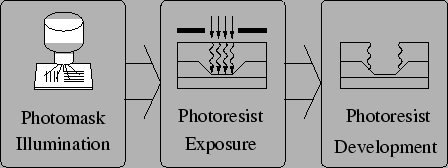



Next: 3.2 Practical Characterization
Up: 3. Photolithography Simulation
Previous: 3. Photolithography Simulation
Basically, three distinct modeling phases are required for
photolithography simulation, namely imaging of the photomask,
photoresist exposure/bleaching, and photoresist development also
including optional or required post-exposure bake steps.
In a typical lithography simulator, each of the three fundamental processes
is accounted for by a separate module as shown in Figure 3.1.
In the overall simulation flow
the three modules are called sequentially as well-defined interfaces exist.
Fortunately, the modules can be treated independently, which is of crucial
importance because very specific simulation methods are required for each step.
The individual tasks are briefly characterized as follows:
- The imaging module describes the illumination of the photomask.
The light propagation through the optical system and the light
transmission through the photomask has to be simulated. The output of the
imaging module is the aerial image, which
is the light intensity incident on top of the wafer.
- The exposure/bleaching module simulates the chemical reaction of
the photosensitive resist. Thereby the light propagation
within the optically nonlinear resist as well as electromagnetic
scattering effects due to a nonplanar topography have to be modeled.
The result of the exposure/bleaching module is the latent
bulk image.
- The development module describes an isotropic etching process,
whereby the etch rate is determined by the previously calculated
bulk image. Depending on the situation a post-exposure bake step
has to be considered by a diffusion simulation to model the smoothing
of the variations in the bulk image. The final developed resist
profile is the result of the overall photolithography simulator.
Figure 3.1:
Basic
modules of a typical photolithography simulator (after [47]).
The three modules of imaging, exposure and development
are called sequentially by the simulator.
|
|




Next: 3.2 Practical Characterization
Up: 3. Photolithography Simulation
Previous: 3. Photolithography Simulation
Heinrich Kirchauer, Institute for Microelectronics, TU Vienna
1998-04-17

